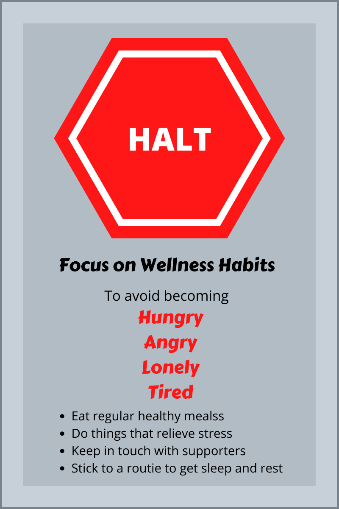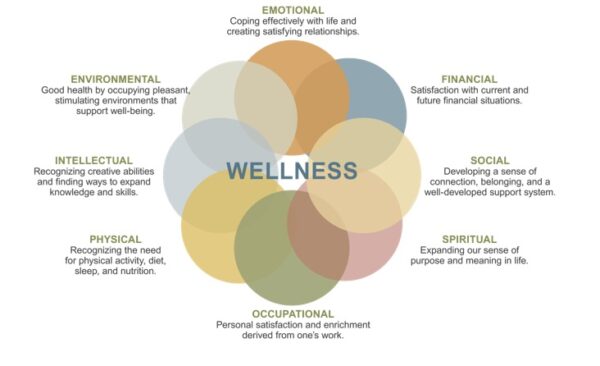Emotional Wellness: is the ability and skills to express feelings, enjoy life, adjust to emotional challenges, cope with stress, and recover from traumatic life experiences. Emotional wellness affects, and is affected by, all the other 7 dimensions. Taking Charge: We can never have complete control over life—things do happen that we don’t expect. Sometimes these present challenges. At other times, such surprises bring gifts. Consider the Serenity Statement, which focuses on accepting what you can’t change and changing what you can. Recognizing where you have control in your life and taking charge of those areas will help you realize there is a lot that you do/can control. There is a lot within our control we can do for our emotional wellness.
Stress and Tension: Stress is an inevitable part of life. If possible, avoid situations and people who trigger you. Deep breathing and relaxation activities are accessible self-care habits that can help, as well as activities such as yoga or journaling. A short self-compassion meditation or a walk outside can shift your perspective. We may not be able to avoid all stressors, but we can redirect how we react and engage in a self-care activity that may impact emotional wellness! There are many activities we can do to release stress and tension. Yoga has become a very popular activity many have found useful to create and restore motional wellness.
Yoga: Yoga is an important wellness tool to help manage stress, improve[i] symptoms of depression, anxiety, and PTSD, as well as enhance emotional well-being and mood. In addition to relieving stress, yoga can help build resilience to stress—the ability to bounce back when experiencing a difficult challenge. Yoga may be the oldest practice of self-development, teaching how to connect your mind, body, and spirit to help you live a more focused life. Yoga uses a series of poses, or body positions, often practiced in a specific order to create a flow. Different types of poses are used to increase flexibility, strength, and balance important strengths for recovery. Over time, these poses help strengthen the body. Slow, deep breathing is coordinated with the poses. Breath control is calming physically.
Breath control also focuses awareness on the body while quieting stressful thoughts. Meditation, which goes along with the Yoga poses, is a time to relax, quiet your mind, and for many enhances emotional wellness. Being more centered can help you cope with hassles and problems that arise in your day-to-day life. Many find Yoga helps them experience a better sleep quality.
Learn more about science and yoga from this 18-minute video from the National Center on Complementary and Integrative Health (National Institutes of Health).
Yoga connects and centers your mind, and body. There are truly many emotional wellness benefits. It is not a cure for addiction, stress or emotional imbalance but can be a useful tool for people in recovery family supporters, peer providers and professionals. Consider learning more about how Yoga!
Other References
https://www.hazeldenbettyford.org/articles/yoga-addiction-recovery
https://www.ncbi.nlm.nih.gov/pmc/articles/PMC5812135/
Kuppili PP, Parmar A, Gupta A, Balhara YPS. Role of Yoga in Management of Substance-use Disorders: A Narrative Review. J Neurosci Rural Pract. 2018;9(1):117-122. doi:10.4103/jnrp.jnrp_243_17.
https://www.ncbi.nlm.nih.gov/pmc/articles/PMC3646290/ Khanna, S., & Greeson, J. M. (2013). A narrative review of yoga and mindfulness as complementary therapies for addiction. Complementary therapies in medicine, 21(3), 244–252. https://doi.org/10.1016/j.ctim.2013
[i] References on the benefits of yoga include: (1) Gard, T., Noggle, J. J., Park, C. L., Vago, D. R., & Wilson, A. (2014). Potential self-regulatory mechanism of yoga for psychological health. Frontiers in Human Neuroscience, 8(article 770), 1-20. (2) Harkness, K. N., Delfabbro, P., Mortimer, J., Hannaford, Z., & Cohen-Woods, S. (2017). Brief report on the psychophysiological effects of a yoga intervention for chronic stress. Journal of Psychophysiology, 31(1), 38-48. (3) Find more facts and references at the National Center for Complementary and Integrative Health at https://nccih.nih.gov/health/yoga/introduction.htm#hed5
HALT: Focus on Wellness Habits

A simple yet powerful mantra associated with wellness habits that has worked for many for decades is the acronym HALT! Keep HALT in mind as you consider what wellness habits to prioritize.
- Hungry. Make it a point to eat regular meals. Nourish your body and mind with good food and good thoughts. Fill yourself with uplifting affirmations and supportive people who fuel your positive qualities and fulfill your basic needs.
- Angry. To avoid feeling angry or irritable, remember to build in short activities that help you relieve your stress, even if just for a few moments. Get outside, if you can, in fresh air or away from your stressor physically or emotionally to regain new perspective.
- Lonely. Create a list of supporters you can phone, text, video call, or even send a handwritten note.
- Tired. The busy holiday season can be stressful and draining for many reasons. Be sure to keep your regular sleep wake time if you can. Pause for a short time to quietly unplug and rest a very short intervals during the day. Even a few moments to rest your eyes and slow your mind can be helpful.
Walking for Health is a brief summary of the benefits of walking, as well as practical strategies for setting goals.
Wellness Tips for the 8 Dimensions of Wellness
These wellness tips are guided by the Eight Dimensions of Wellness (Swarbrick, 2006).

Everyone can benefit from improved wellness. It’s important to pause and think about wellness, and consider one’s own rituals, habits, and routines and whether there are areas for improvement.
Emotional Wellness
Coping effectively with life and creating satisfying relationships
In the COR syndemic, many people have realized the value of their relationships with others, and with self. For many, coping strategies have been put to the test with the recent, and current, elevated individual, community, and collective trauma experiences. Taking care of one’s emotional wellness can include activities like spending fulfilling time in reflection, whether that’s journaling, meditating, or reading.
Environmental Wellness
Good health by occupying pleasant, stimulating environments that support well-being
When the COVID-19 pandemic began, people around the country flocked to outdoor spaces, seeking safe environments for individual and social activity. At the same time, racial unrest and police violence caused many outdoor areas and communities to feel unsafe. It is important for people to find or create an environment to support well-being. This may include being outside or in nature or using colors, textures, scents, and lighting to create pleasant space in one’s home or room.
Financial Wellness
Satisfaction with current and future financial situations
Every dimension of wellness has been impacted by the COR syndemic. Many people have been laid off or otherwise lost their jobs or primary sources of income. Financial wellness can feel like a particularly difficult area for people right now. If feeling dissatisfied with the current financial situations, it can be important to process, plan, and strategize how to improve the current and future outlook. Access to money itself can feel out of our control, but our sense of financial wellness is in our control. Trying things like participating in free events, meal prepping for the week, taking free debt management courses at a local credit union, or cutting out non-essential costs can help people gain some control.
Social Wellness
Developing a sense of connection, belonging, and a well-developed support system
The COR syndemic has highlighted, for many, the value of connection and importance of a meaningful, compassionate support system. At the same time, many people can feel burnt out from virtual meetups, or anxious about in-person gatherings. Finding balance between solitude and connection with others is important. Having a sense of belonging can come from connecting with others with shared interests. Local libraries, community wellness centers, co-working spaces, and various meetup groups can be helpful ways for meeting new people to build with. Taking time to nurture existing connections is important. Taking time to call, text, or message people to let them know they’re being thought about can go a long way.
Spiritual Wellness
Expanding our sense of purpose and meaning in life
Spiritual wellness has been challenged for many people in the COR syndemic. And, for many, the epidemics have helped to create a sense of purpose and meaning in life. Being connected to something larger than ourselves, or feeling our own lives have meaning, is an important part of overall well-being. All of the dimensions of wellness are connected – enhancing spiritual wellness can include things like stargazing or enjoying a silent walk in nature (environmental), or talking about the meaning of life with trusted loved ones (social).
Occupational Wellness
Personal satisfaction and enrichment derived from one’s work
Like all dimensions of wellness, occupational wellness will vary from person to person and what “work” means for them. For some people, their work includes a career or other job. For others, it may be caretaking or being a carer. Being a student or learner, participating in a skills training or independently exploring new skills and trades are all examples of work. In occupational wellness, the work is not necessarily a paid job. It’s important that whatever this work is feels meaningful, and brings personal satisfaction and enrichment.
Physical Wellness
Recognizing the need for physical activity, diet, sleep, and nutrition
Our physical wellness can impact the habits, routines, and rituals we engage in for other dimensions of wellness. Without proper nutrition or sleep, it can be hard to have the energy or motivation to engage in wellness-strengthening activities. It’s important to take the time to move the body and participate in accessible physical activity. Physical wellness isn’t necessarily about starting a gym routine or transforming eating habits, especially after many people’s routines were transformed by the COR syndemic for many reasons. Physical wellness can be built by small, daily choices to move, create regular sleep habits, and increase awareness of food and beverage choices. September is a great time for engaging in outdoor physical activities, enjoying farm-fresh foods, and adjusting sleep habits as the days become shorter.
Intellectual Wellness
Recognizing creative abilities and finding ways to expand knowledge and skills
Just as expanding knowledge and skills can support occupational wellness, it can enhance intellectual wellness. Everyone has creative strengths, and it can be helpful to expand on the knowledge and skills that contribute to these strengths. If someone is unsure about what creative abilities they possess, journaling or brainstorming might help with recognizing what they are. Writing, reading, creating art, and dancing all enhance intellectual wellness, as does putting together puzzles, visiting museums, or doing a crossword puzzle.
For More Wellness Tips and Tools
Learn the Eight Dimensions of Wellness (poster) | SAMHSA
Creating a Healthier Life: A Step-By-Step Guide to Wellness in English and Spanish | SAMHSA
